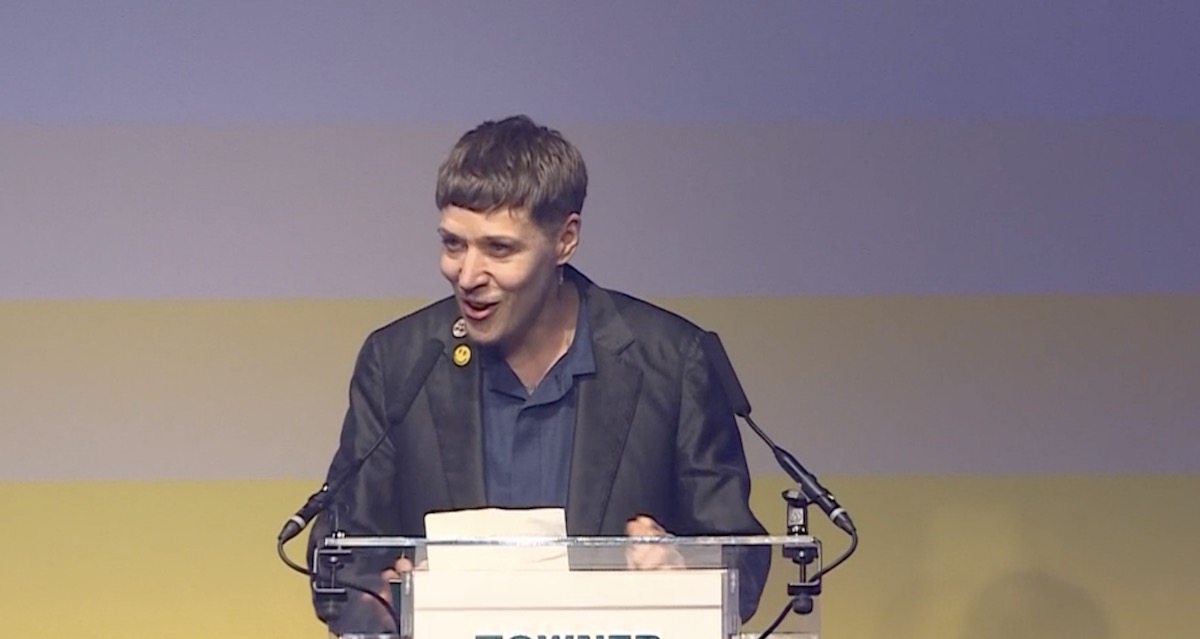In the notable annals of contemporary art, one accolade stands as a career topper, and that is the Turner Prize. This year, the Towner Gallery in Eastbourne hosted the gala awards dinner. The nominees Ghislaine Leung, Jesse Darling, Barbara Walker and Rory Pilgrim
Sue Hubbard wrote in her review of the Turner Prize Exhibition in September: “Working with sculpture, drawing and installation, takes his cues from Eastbourne’s coastal location to explore notions of borders, the body, nature, nationhood and exclusion. Bits of what look like bent rail track that appears to lead nowhere in particular project out of the wall and curl onto the floor in a pointless roller coaster. Elsewhere, a frilly pelmet of crochet lace, the sort seen in many an Eastbourne window, seems to suggest the hidebound and the moribund. Hung together along with a line of razor wire, it might not be fanciful to read this as an oblique reference to Brexit and our closed borders. A shelf, also decorated with a trim of crochet, holds a mortuary of the white clay limbs of dolls. A reference to bodies broken, perhaps, on the wheel of political bureaucracy? Metal barriers, the sort used for ‘kettling’ as a form of crowd control, litter the gallery. The longer one stays around the work, the more uncomfortable and dystopian it feels.”

Recognised for his outstanding solo showcases, “No Medals, No Ribbons” at Modern Art Oxford and “Enclosures” at Camden Art Centre, Darling emerges as a formidable artist whose portfolio spans sculptures and installations. Delving into the intricacies of the human form and the fragility inherent in power structures, Darling’s work intrigues with its ability to evoke vulnerability.
The jury, in particular, marvelled at Darling’s adept manipulation of materials, deftly expressing the chaotic intricacies of life’s reality. These exhibitions served as a testament to the depth and sincerity of Darling’s artistic practice, laying bare the world’s underlying fragility. What stood out was Darling’s refusal to conform to the conventional, defying easy categorisation and presenting a self unapologetically complex and enigmatic to the observer.
Over the years, controversy and artistic merit have made the Turner Prize a watchable mainstream event. However, the art is rarely mainstream, and the prize gravitates towards plucking the most obscure artists or mediums out of the wilderness and then shoving them back down again.
Since its inauguration in 1984, the Tate Gallery has organised the award. The prize was, once upon a time, for those under 50. This benchmark was eliminated when deemed ageist, and the YBAs simultaneously hit 50. Tate also rotated this event to spend every other year in a provincial UK museum. Thus, the excellent Towner in Eastbourne has hosted the event this year.
The Turner has been a compass guiding the trajectory of British contemporary art for many years. Consecutive judging panels work overtime, creating neither a visual nor a conventional shortlist. Collectives, Video Art, Performance Art, Installation Art, Designers, and Architecture top the bill of mediums used. Rarely will you find anything as mundane as a painter or sculptor in the Turner arsenal, and when you do, they usually win.
Named after the eminent landscape painter J.M.W. Turner, the prize emerged as a response to the acute need to acknowledge and celebrate contemporary British artists. The early years were marked by a wave of painters and sculptors, which saw the likes of Malcolm Morley, Howard Hodgkin, and Richard Deacon win, and then a reaction was provoked that the Turner Prize was not a lifetime achievement award.
As the 1990s unfolded, the Turner Prize became a crucible of controversy and dialogue. Damien Hirst’s infamous shark in formaldehyde, the embodiment of provocative selection, set the tone for a period defined by the rise of the Young British Artists (YBAs), including luminaries such as Rachel Whiteread and Chris Ofili.
The new millennium ushered in a fresh era for the Turner Prize, with winners like Grayson Perry challenging traditional mediums and Mark Wallinger bringing political engagement to the forefront. The third decade, spanning from 2011 to 2020– witnessed a commitment to inclusivity, with the removal of age limits in 2017. Lubaina Himid’s historic win as the first black woman in 2017 marked a pivotal moment in championing diverse voices in contemporary art.
As we enter the current decade, the Turner Prize remains a dynamic force, adapting to the ever-shifting landscape of contemporary art. It stands not only as a testament to the indomitable spirit of British contemporary art but also as a mirror reflecting the ever-changing visage of our cultural landscape. The Turner Prize’s captivating narrative is one of risk, reward, and the relentless pursuit of artistic innovation—a story that continues to unfold each year.
The award is £55,000 – £25,000 goes to the winner and £10,000 each goes to the other shortlisted artists. Not exactly a big giveaway in this day and age however the winner will certainly gain gallery representation, if they don’t already have it and their prices will soar.
Words/Photos P C Robinson © Artlyst 2023
Read: Sue Hubbard’s review of this year’s Turner Prize HERE
Ghislaine Leung: Interview of the Month November 2023 – Paul Carey-Kent

